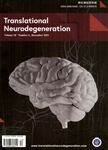Freezing of gait in Parkinson’s disease: pathophysiology, risk factors and treatments
作者机构:Department of NeurologyRuijin Hospital Affiliated to Shanghai Jiao Tong University School of MedicineShanghaiChina Co-innovation Center of NeuroregenerationNantong UniversityNantongJiangsu ProvinceChina
出 版 物:《Translational Neurodegeneration》 (转化神经变性病(英文))
年 卷 期:2020年第9卷第2期
页 面:132-153页
核心收录:
学科分类:1002[医学-临床医学] 100204[医学-神经病学] 10[医学]
基 金:This work was supported by grants from the National Natural Science Foundation of China(81430022,91332107,81371407,81971183) Clinical Research Center,Shanghai Jiao Tong University School of Medicine(2017NKX001)
主 题:Freezing of gait Parkinson's disease Pathophysiology Risk factor Pharmacological treatment Nonpharmacological treatment
摘 要:Background Freezing of gait(FOG)is a common,disabling symptom of Parkinson’s disease(PD),but the mechanisms and treatments of FOG remain great challenges for clinicians and *** main focus of this review is to summarize the possible mechanisms underlying FOG,the risk factors for screening and predicting the onset of FOG,and the clinical trials involving various therapeutic *** addition,the limitations and recommendations for future research design are also *** body In the mechanism section,we briefly introduced the physiological process of gait control and hypotheses about the mechanism of *** the risk factor section,gait disorders,PIGD phenotype,lower striatal DAT uptake were found to be independent risk factors of FOG with consistent *** the treatment section,we summarized the clinical trials of pharmacological and non-pharmacological *** the limited effectiveness of current medications for FOG,especially levodopa resistant FOG,there were some drugs that showed promise such as istradefylline and ***-pharmacological treatments encompass invasive brain and spinal cord stimulation,noninvasive repetitive transcranial magnetic stimulation(rTMS)or transcranial direct current stimulation(tDCS)and vagus nerve stimulation(VNS),and physiotherapeutic approaches including cues and other training *** novel therapeutic strategies seem to be effective,such as rTMS over supplementary motor area(SMA),dual-site DBS,spinal cord stimulation(SCS)and *** physiotherapy,wearable cueing devices seem to be generally effective and *** FOG model hypotheses are helpful for better understanding and characterizing FOG and they provide clues for further research *** risk factors of FOG have been identified,but need combinatorial optimization for predicting FOG more *** firm conclusions cannot be drawn on therapeutic efficacy,the literature suggested that some the



